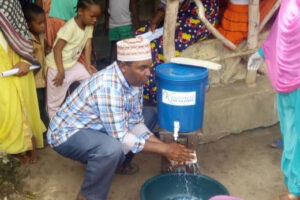ANALYSTS have welcomed the constitutional amendments endorsed during the 10th National Congress of the ruling Chama Cha Mapinduzi (CCM) that sat for two days at the Jakaya kikwete Convention Centre in the country’s capital, Dodoma.
The endorsed amendments aim at improving efficiency and increasing members’ engagement in the party’s top level meetings.
Speaking while presiding over the meeting on Wednesday, CCM national chairperson President Samia Suluhu Hassan said the amendments aim to increase the number of National Executive Committee (NEC) members from the previous 15 seats in the mainland and Zanzibar to 20 for both sides.
Similarly, she indicated raising the number of Central Committee members from seven appointees to 10 as well as the inclusion of Heads of Units of various wings at national level in the meetings.
Elaborating, Dr Samia noted that the decision to create the position of Regional Secretary for Publicity and Ideology on employment basis was to promote accountability.
“Formerly the position focused on selecting people who would only sing in meetings instead of publicising the party agenda,” she said.
Speaking to the ‘Daily News’ in a telephone interview yesterday, analysts said the changes have come at the right time and would help the party in realising all its targets.
A lecturer at the Tumaini University Dar es Salaam College (Tudarco) Rachel Yusuph said the changes widen the member’s representation in the party’s decision making organs.
“The increase in number of members in NEC meetings assures effective representation of party members from both sides of the union, it also cements further the national union, peace and harmony,” she said.
According to her, the increased number of NEC members will also help in making rational decisions since there will be a room for more people to express their opinions that in the end will be used in making proper final decisions.
For his part, a political analyst Mr Vincent Ndunguru commended the move by the party to start employing its regional secretaries for ideology and publicity.
He said the decision also aims to enhance efficiency on the party’s operations from grassroots level as the positions will now be held by competent individuals.
“Having competent and qualified secretaries of ideology and publicity at regional level will help in reducing a workload of party’s top officials since their roles will be carried out by these employees who will now be working full time,” he said.
Get the latest in African news delivered straight to your inbox
His views were in line with the opinion aired by the seasoned political analyst Goodluck Ng’ingo who said the constitutional amendment will bring changes within the party for future prosperity.
“It’s a good decision to level a number of NEC members from mainland and Zanzibar,” he said, noting that the decision has come at a right time when CCM has got new leaders who have been elected through democratic process.
Mr Ng’ingo also commended the decision of employing the party’s regional secretaries for ideology and publicity, saying this will make the party vibrant at all levels.
“Since these staff will be working full time, they will help in making the branches and party wings vibrant throughout the year,” he said.
Earlier, CCM Secretary General, Mr Daniel Chongolo noted that the amendment carried out emanated from recommendations made by the party’s Central Committee in its various meetings.
Mr Chongolo outlined the objectives of carrying out the Constitutional amendments as including renewing the structure of the party, extending the scope of engagement of its members as well as strengthening democracy within the party and its various wings.
Source: Original Media Source
Share this news
This Year’s Most Read News Stories

Inside Tanzania’s Life-Saving Birthcare Model

Tanzania is winning the battle against maternal and newborn deaths, as the latest numbers reveal a significant decline.
“Tanzania is committed to reducing maternal and newborn mortality and ensuring safe deliveries as part of the national development plan. The Safer Births Bundle of Care is one of the key strategies supporting this effort,” said Dr. Benjamin Kamala, the Senior Research Scientist at Haydom Lutheran Hospital and Principal Investigator for the program, leading its implementation across five regions in Tanzania.
A groundbreaking study published in the New England Journal of Medicine shows that the innovative health program in Tanzania – centered on regular, on-the-job training for healthcare workers – reduced maternal deaths by 75% and early newborn deaths by 40%. The three-year study, conducted across 30 high-burden healthcare facilities in Tanzania, tracked approximately 300,000 mother-baby pairs under the Safer Births Bundle of Care (SBBC) programme. The programme focuses on improving care for mothers and babies during the day of birth, the critical time when a woman goes into labor and delivers her baby.
Maternal health is a key focus of the United Nations Sustainable Development Goals (SDGs), specifically Target 3.1, which aims to reduce the global maternal mortality ratio to fewer than 70 deaths per 100,000 live births by 2030.
Tanzania’s program combines continuous, simulation-based training for frontline healthcare workers alongside innovative clinical tools to improve labour monitoring (fetal heart rate monitoring) and newborn resuscitation.It also uses data to drive ongoing improvements, ensuring that healthcare workers have the skills, confidence, and competence to manage birth-related complications for both mothers and newborns.
“We work closely with healthcare workers, equipping them with the necessary tools to improve the quality of care, ensuring they can effectively manage both mothers and babies during and after childbirth,” Dr. Kamala said, which helps them build on over a decade of innovative research and collaboration to improve care during childbirth.
“To give you a sense of the scale of the burden of maternal and newborn mortality in Tanzania when the Safer Births Bundles of Care program was in early development in 2015/16, there were around 556 maternal deaths per 100,000 live births and 25 neonatal deaths per 1,000 live births,” he said.
The published study demonstrates the “transformative impact” of the Safer Births Bundle of Care program conducted across 30 hospitals in five high-burden regions of Tanzania, where there were about 300,000 mother-baby pairs.
Maternal deaths at the start of the program were recorded at 240 per 100,000 live births, with postpartum hemorrhage and hypertensive disorders being the leading causes of death, he said. Over the 24-month study period, this number dropped to approximately 60 per 100,000 live births, representing a 75% reduction. The number of newborn deaths – which are primarily due to breathing difficulties and complications related to prematurity – declined by 40% – from 7 deaths per 1,000 live births to 4 deaths per 1,000 live births.
“These results are remarkable,” Dr. Kamala said.
According to Dr. Kamala, the 75% reduction in maternal deaths was not expected, and a key lesson was the important role of the in-situ team simulations – including for postpartum bleeding – with reflective debriefings that trained facilitators led.
“This seems to be a major part of the success of the program,” he said. “We are delighted by these results and hope that other countries adopt and scale the Safer Births Bundle of Care program… Beyond the numbers, the Safer Births Bundle of Care program has fostered a dramatic culture shift in our healthcare system,” he said. “Healthcare workers are now more confident and better equipped to handle birth-related complications for both mothers and babies.”
Maternal death drop
Dr. Kamala attributed the 60-70% reduction in newborn deaths in Geita and Manyara to several factors.
“Firstly, Manyara was the first site for implementation, giving the region more time to adapt and experience the impact of the program. Most importantly, both regions had a high burden of stillbirths and neonatal deaths, making them ideal targets for focused intervention. As a result, newborn deaths decreased by 60-70%, showcasing a clear positive impact on newborn survival,” he said.
Dr. Kamala said another possible explanation is the differences in the culture of practices, where some health facilities reported inaccurate data due to the fear of blame and shame. However, with the project’s implementation, reporting became more accurate after mplementation. Some regions, such as Tabora, reported an increase in the number of referrals to the study hospitals from other care centers after the program was implemented. These were more likely to be late admissions, which increase the likelihood of poor health outcomes, he said.
After the implementation of the program, there was a 40% decrease in newborn deaths within the first 24 hours after birth, according to the study.
Dr. Kamala said Tanzania’s remarkable progress in reducing maternal mortality by 80% is driven by strategic investments and innovative programs focused on improving maternal and child survival rates.
“Over 2,000 new healthcare facilities have been developed, free health services are being provided to expectant mothers and children under the age of five, and emergency obstetric care – including better transport to hospitals in rural areas are helping to ensure timely, life-saving interventions.
“Most importantly, the Ministry of Health works in collaboration with healthcare workers, hospitals, and development partners to strengthen the skills of frontline healthcare workers, which has been a key factor in driving this progress.
“Political leadership, alongside strategic partnerships and financing, has been crucial in driving progress in maternal and newborn health,” he said.
The program was made possible by the support of the Global Financing Facility for Women, Children, and Adolescents, Norad, UNICEF, and Laerdal Global Health, as well as the Ministry of Health and Haydom Lutheran Hospital. Their partnership and investment enabled the scaling of the Safer Births Bundle of Care to 30 hospitals and supported the research. “The government has now scaled the program to over 150 sites, and there are plans for further expansion to three regions this year and then nationally,” he said.
Dr. Kamala outlined key policy recommendations for other governments can adopt to prioritize maternal health.
“Firstly, it focuses on cost-effective and relatively simple interventions that are essential to preventing maternal and newborn deaths. For example, stronger primary healthcare that is delivered in the community and a well-trained healthcare workforce are also critical. Additionally, working in close collaboration with national, regional, and local health authorities is key.”
He said Tanzania’s approach, where the Safer Births Bundle of Care program was successfully scaled and sustained by aligning the initiative with national guidelines for obstetrical and newborn care. In addition, the creation of mentorship programs and regular supervision has helped to sustain the results.
Looking ahead
Tanzania now plans to expand to three new regions in 2025, followed by a nationwide rollout.
The success of the program has attracted interest from other countries, with Botswana, Ethiopia, Lesotho, and Namibia expressing interest in adapting the program to their healthcare system. In Nigeria, the program has already been launched in two states, Gombe and Borno, marking a significant step in its scaling.
Source: allafrica.com

Tanzania’s path to 4Rs: The President Samia’s era
Tanzania has embarked on a journey of resilience, rebuilding, reconciliation, and reform under the leadership of President Samia Suluhu Hassan.Continue Reading

Villagers on Pemba Island lack clean sanitized water
Eight villages on Pemba Island have lacked clean and safe water service while complaining to the Zanzibar Water Authority for failing to solve the water problem in their villages.Continue Reading










